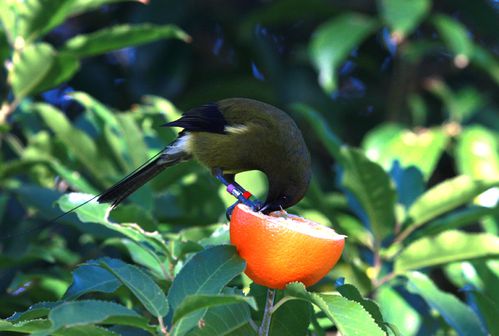The Bellbird (Anthornis melanura) translocation programme in the south inner Hauraki Gulf
The Auckland Regional Council (ARC) and the Department of Conservation (DoC) have worked together on a Bellbird reintroduction project on 2 islands of the south inner Hauraki Gulf: Waiheke Island and Motuihe Island.
The Bellbird (Anthornis melanura), named Korimako in Maori Language, is an endemic bird of New-Zealand, still encountered and locally common in both mainland islands. However the Korimako disappeared from the north of the northern island during the XXe century (excepted for some offshore islands). The main hypothesis to explain its local extinction are its habitat (native forest) destruction, and its predation by European introduced mustelids and rats. Some think that a european introduced bird disease could have widely affected the population. In Auckland region, the Bellbird disappeared from Waiheke Island one century ago, and the last individuals have been seen on Motuihe Island in the 70's.

Male Bellbird (Anthornis melanura)
The Bellbird belongs to the honeyeater bird family, meaning that an high proportion of its alimentation is based on flowers nectar and berries. He plays a key role in the New-Zealand forest ecosystems, as a pollinator and a seeds disperser. Moreover the Bellbird has the particularity to have a loud and melodious song, very nice to hear!

Female Bellbird feeding on Kohekohe flower
A similar Bellbird reintroduction plan had already be attempted on Waiheke Island in the late 90's, but lead to a failure. 2 hypothesis are currentely proposed as its cause:
- the absence at this time of any mammals pest control in the release sites (rats, stoats, ferrets, cats...)
- the high mobility of the birds which lead to a fast and wide range of dispersal after release
Rakino Island, located a few kilometres north of Motuihe Island, was naturally colonised by the Bellbird, with birds coming from the sanctuary island of Tiritiri Matangi further north. So the nearby Rangitoto and Motutapu islands, whose mammals pest have been eradicated a few time ago, are likely to be naturally colonised. It is the same case with Waiheke and Motuihe Islands, through a “step by step” dispersal and settlement (see the map).
However it was shown that the source population (from Tiritiri Matangi) is genetically poor, probably since the population bottleneck that occurred in the mid 20th century, when the surface of remnant bush was the lowest.
That's why the Korimako reintroduction plan on Waiheke/Motuihe Islands aims at mixing birds coming from the Tiritiri population to birds coming from the Tawharanui Regional Park population. This population was naturally established from birds coming from the Little Barrier Island population, which is genetically distinct from the Tiritiri one. An improvement of the translocated population genetic biodiversity is expected through this plan.
75 birds were caught within each of these 2 source populations, with a balanced proportion of males/females and adults/juveniles. Those 2 populations were assessed as healthy enough (600 birds, good productivity of chicks) to be harvested of such an amount of birds without being threatened.
The 2010 translocation plan involved 150 birds, released in 3 predator-managed site:
- Motuihe Island (179 ha): the island is pest-free since 2005
- Whakanewa Regional Park (247 ha): mammals predators are controlled thanks to the classic mainland islands methods: poisoned baits and mustelids traps lines
- Private Reserve of Fenwick (360 ha): mammals predators are controlled thanks to the classic mainland islands methods: poisoned baits and mustelids traps line

Locations of the source populations and of the release sites
All of the released birds were colour-banded and are individually identifiable thanks to their unique colour combination. 38 of them were fitted with a radiotransmitter which allowed to locate them daily and to monitor their dispersal after release. 12 birds out of the 50 birds released on Motuihe were fitted with such an equipment, while respectively 12/50 and 14/50 were fitted for the 2 released sites of Waiheke (Fenwick Reserve and Whakanewa RP).

Bellbird colour-banded (read red-green/violet-Metal) and fitted with a radiotransmitter (see wire above the tail)
Feeders providing sugar water and fruits were placed in each of the release sites, in order to retain as many birds as possible and even if the established bush habitats in the release sites are supposed to provide enough food. Moreover the birds coming from Tiritiri are used to eating at the feeders, and are expected to be imitated by the Tawharanui birds.

Feeder providing extra food for the Bellbirds

Established bush on Motuihe

Bellbird feeding on natural food provided by the established bush on Motuihe
The Bellbird translocation project in Auckland region aims at achieving several outcomes:
- to restore a sustainable population of a locally extinct endemic bird, within a region where the specie used to live until 40 years ago
- to restore a key component of forest ecosystem functionality in the Auckland region and in the southern inner Hauraki Gulf
- to promote biodiversity conservation issues to a non-specialist public thanks to a popular specie
- to experiment and to monitor different translocation methods: pest-free release sites vs pest-controlled release sites, sound anchoring...
- to monitor accurately the Bellbirds dispersal after release thanks to telemetry and colour-banding
The Bellbird reintroduction on Motuihe is the first try attempted on a pest-free area! And the whole translocation programme, involving 150 Bellbirds, is the biggest ever attempted in New-Zealand, considering the number of birds caught and released!
